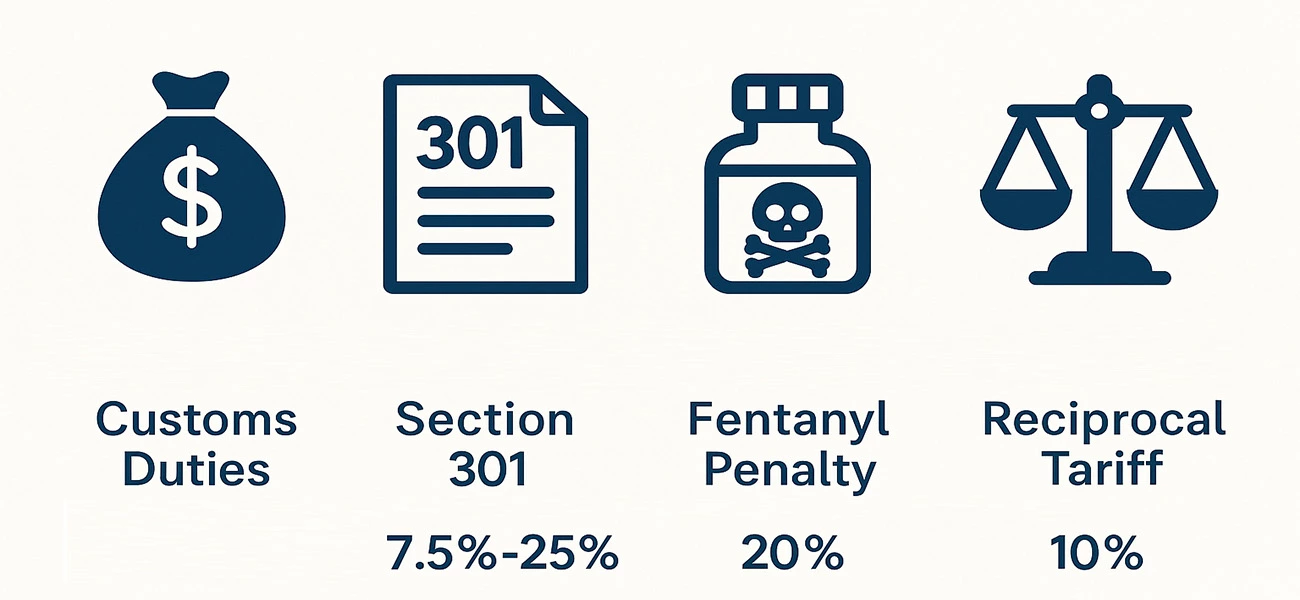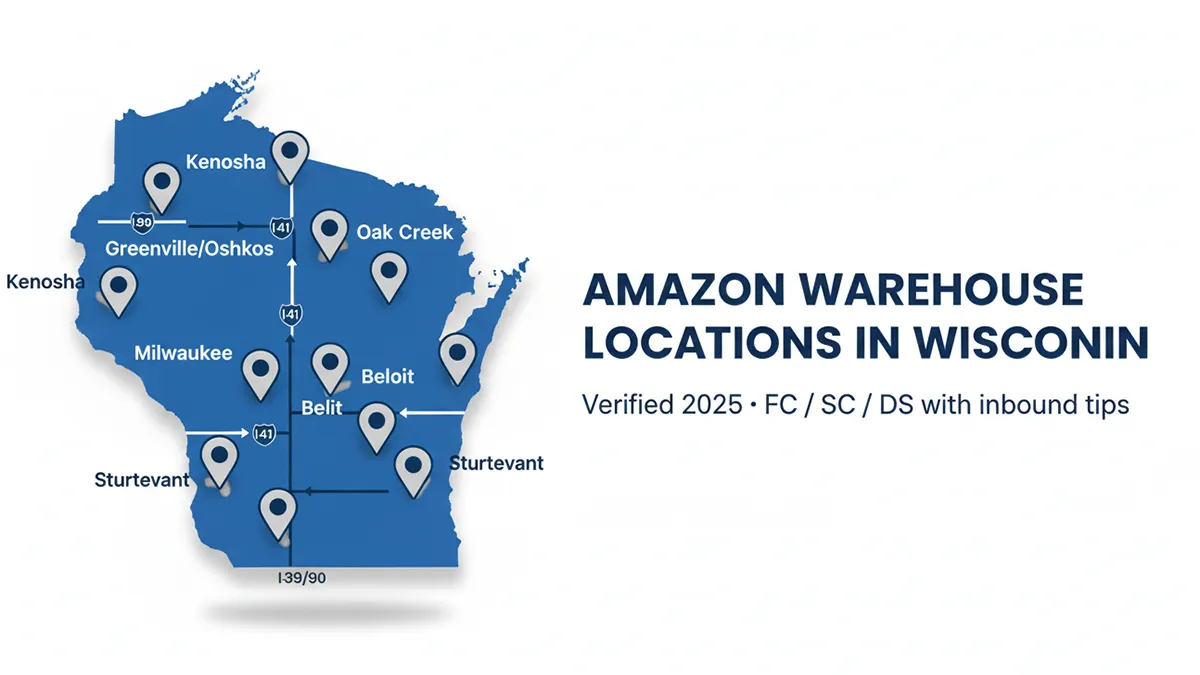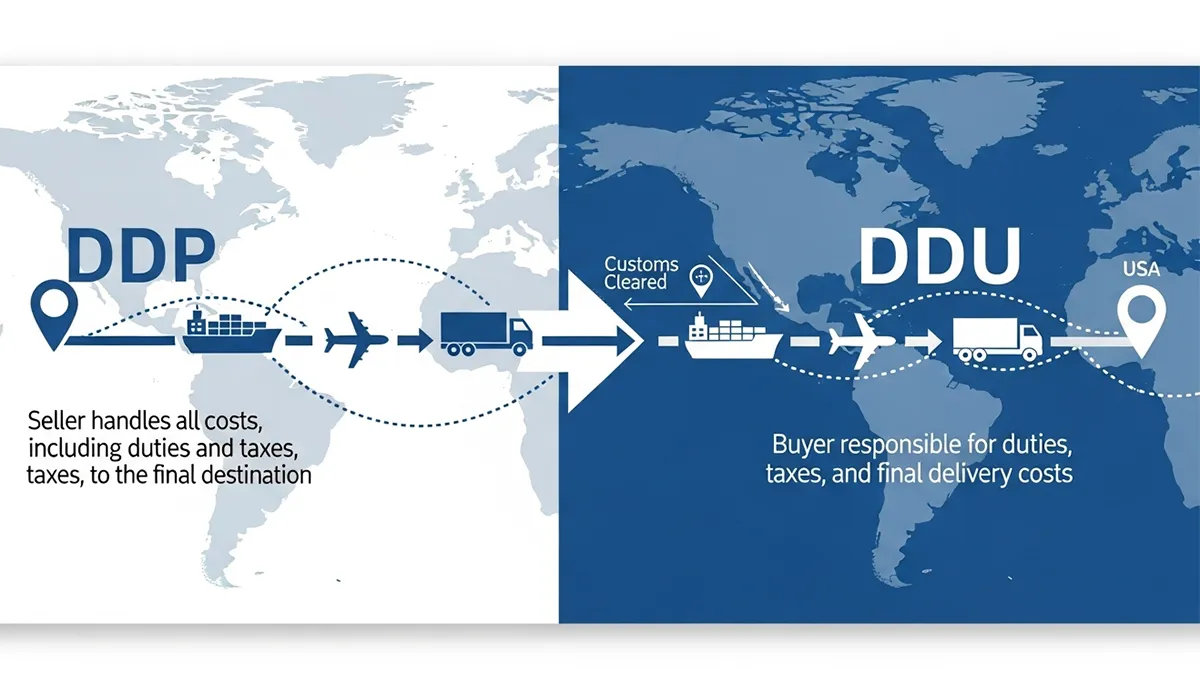US Import Tax & Tariffs from China | 2025 Guide
Every importer knows the importance of making budgets before shipping. A very important part of your total shipping costs is the US import tax from China. The calculation of import duties and tariffs from China has become even more complex in recent years due to the US-China trade tariffs, and with significant new US policies taking effect in 2025, this complexity is set to increase. To avoid unpleasant surprises and accurately budget for customs fees from China to US, you must understand the HS codes, the fees involved, and how to calculate import duty from China to USA accurately. This article will cover all this information about import taxes and the latest 2025 China tariffs.
1. What is Import Tax?
Import tax is a fee that you pay when you bring in goods from one country into another. In the case of the USA, it’s a charge on products you import from other countries, like China, often referred to as customs charges from China to USA. It is usually collected at the point of import by the customs authorities of that country. Countries charge import taxes for three main reasons:
-
To protect local manufacturers by making imported goods more expensive for consumers.
-
To raise revenue for the government.
-
To control the market or respond to trade disputes, which is the case with the current tariffs on Chinese imports.
Understanding import tax from China to US is important because it affects overall costs and determines your business’s profit margin. You need to factor in these charges when planning your budget.
Unlike many countries that use the CIF value to calculate customs value, the US uses the FOB value. The CBP believes customs value should be determined based on the actual price “payable” or “paid” for the goods before they are shipped to the USA. The FOB value includes the cost of the goods and any additional costs up to the point of exportation but does not include shipping and insurance costs.
Your tax is usually calculated as a percentage of this value, along with other duties and tariffs from China to USA, which we’ll explain as we go further in this article.

2. Types of Import Taxes & Tariffs in the USA
The US Customs and Border Protection (CBP) is responsible for listing the fees you pay when shipping from China. Based on their value, your goods will be classified as either a formal or informal entry.
-
Informal entry is for imported goods worth less than $2,500.
-
Formal entry is for imported goods worth more than $2,500.
Here are the major import duties from China to USA you should expect:
1. Customs Duties
CBP enforces an import duty/customs duty on any goods that cross the border into the USA. It is the biggest part of your custom tax from China to USA, but goods valued below $800 are not subject to this duty. As you would expect, different goods have different duty rates. The import duty rates from China to USA are determined by the Harmonized Tariff Schedule (HTS) code for your product and the country of origin.
2. Excise Taxes
Excise taxes only apply to specific goods imported into the U.S. Goods like alcohol, tobacco, and gasoline. You only have to worry about it if your goods fall under these categories.
3. Anti-Dumping Duties and Countervailing Duties
These are applied to specific goods to protect U.S. manufacturers from what are considered unfair trade practices, such as selling goods below market value (dumping) or benefiting from foreign government subsidies.
4. User Fees
-
Harbor Maintenance Fee (HMF): This is a small fee (0.125% of the shipment’s value) that you pay for sea-shipped goods entering through U.S. ports.
-
Merchandise Processing Fee (MPF): The MPF funds CBP operations and differs for formal or informal entries. The table below explains the MPF rates.
| Entry Type | Value of Goods | MPF Rate | Categories (Examples) | Minimum Fee | Maximum Fee |
| Informal Entries | Less than $2,500 | $2.22 | Automated, not prepared by CBP personnel | N/A | N/A |
| $6.66 | Manual, not prepared by CBP personnel | ||||
| $9.99 | Automated or manual, prepared by CBP personnel | ||||
| Formal Entries | $2,500 or more | 0.3464% of merchandise value | General commercial imports | $31.67 | $614.35 |
5. Section 301 Tariffs: The "China Tariffs"
Section 301 tariffs are additional tariffs the United States imposes on certain products imported from China to address unfair trade practices. As of early 2025, these US tariffs on Chinese imports are still active. They are separate from the regular customs duties and can range from 7.5% to 25%.
6. New 2025 Tariffs: Fentanyl Penalty & Reciprocal Duties
In addition to the existing Section 301 tariffs, importers must be aware of new US policies for 2025 that could significantly impact costs:
-
20% Fentanyl Penalty Tariff: The U.S. government has introduced a new punitive tariff of 20% on a wide range of Chinese goods. This measure is intended as a penalty aimed at pressuring China on issues related to Fentanyl trafficking.
-
10% Reciprocal Tariff: Furthermore, a broad 10% "reciprocal tariff" has been established to equalize the tariff rates between the two countries.
It is crucial to understand that these new tariffs may apply on top of regular customs duties and existing Section 301 tariffs. This means the total tariff rate on a single product could increase dramatically.
3. Understanding the HS and HTS codes
The Harmonized System (HS) code is an international standardized numerical method of classifying traded products. It is managed by the World Customs Organization (WCO) and used by over 200 countries to determine the import duty percentage. The HTS (Harmonized Tariff Schedule) code is the US-specific version, extending the international 6-digit HS code to 10 digits for more detailed classification. Correctly identifying your product's HTS code is the first step to determining your tax rate.
4. How is Import Tax from China to the US Calculated?
Many importers search for an "import tax from China to USA 2025 calculator" or a "China to US tariff calculator". While online tools provide a good estimate, this section will show you how to calculate tariffs from China yourself for the most accurate budget, especially with the new 2025 tariffs.
Step 1: Identify the HTS Code
First, classify your goods accurately by looking up your HTS code on the official U.S. International Trade Commission (USITC) website.
Step 2: Find the Duty & Tariff Rates
The USITC website will show the regular duty rate. You must also check for additional tariffs like Section 301 duties and the new 2025 tariffs that may apply to your specific HTS code.
Step 3: Determine the Customs Value
This is the FOB value of your goods, which should be on your commercial invoice.
Step 4: Calculate All Duties and Fees
Add up all applicable percentages (regular duty + Section 301 tariff + new 2025 tariffs) and multiply by the customs value. Then, add the flat fees like MPF and HMF.
Example Calculation:
Let's say a $10,000 shipment of coffee makers has a 3.7% regular duty and a 7.5% Section 301 tariff.
-
Base Duty & Tariffs: $10,000 x (3.7% + 7.5%) = $1,120
-
MPF Fee: $10,000 x 0.3464% = $34.64
-
HMF Fee: $10,000 x 0.125% = $12.50
-
Subtotal: $1,167.14
IMPORTANT NOTE ON NEW 2025 TARIFFS:
If this shipment were also subject to the new 10% Reciprocal Tariff:
-
New Reciprocal Tariff: $10,000 x 10% = $1,000
-
New Fentanyl Tariff: $10,000 x 20% = $2,000
-
New Estimated Total Import Tax: $1,167.14 + $3,000 = $4,167.14
This highlights why consulting with a customs expert in 2025 is more critical than ever.
5. Can I Get Import Tax Exemptions?
Yes, in some situations. Shipments valued under the de minimis threshold of $800 are typically exempt from duties and taxes. Additionally, certain specific products are classified as duty-free under the HTS.
6. How to Reduce Import Duties & Tariffs from China
While tariffs are often unavoidable, you can take steps to manage costs. These include ensuring correct HTS classification, taking advantage of the $800 de minimis rule for smaller shipments, and exploring options like duty drawback programs if goods are to be re-exported.
7. How to Pay Import Tax & Clear Customs
Your customs broker or freight forwarder will handle the payment process on your behalf as part of the customs clearance service. They will pay CBP directly and invoice you for the total amount. Alternatively, if using a DDP (Delivered Duty Paid) shipping term, the seller is responsible for these costs.
8. Frequently Asked Questions (FAQ) about US Import Tax from China
1. How do the new 2025 Fentanyl and Reciprocal tariffs affect my total import cost?
These new tariffs are generally applied on top of regular customs duties and any applicable Section 301 tariffs. This means your total tax rate could increase by an additional 10% to 30% or more, depending on your product. This makes accurate classification and consultation with a customs expert more critical than ever to understand your final landed cost.
2. Are the Section 301 tariffs on Chinese goods permanent?
The Section 301 tariffs are not necessarily permanent and are subject to change based on the U.S. trade policy. It's crucial to check the latest updates from the U.S. Trade Representative (USTR) or consult with a customs broker.
3. How does the $800 de minimis rule work for imports from China?
The de minimis rule allows a single shipment with a retail value of $800 or less to enter the U.S. free of duties and taxes, provided it's imported by one person on a single day. You cannot break down a larger shipment into multiple smaller ones to abuse this rule.
4. Who is responsible for paying the import tax? The shipper or the buyer?
This is determined by the Incoterms® agreed upon. Under terms like FOB, the buyer/importer is responsible. If you use DDP (Delivered Duty Paid), the seller/shipper is responsible.
5. What happens if I use the wrong HTS code for my products?
Using an incorrect HTS code can lead to significant problems, including fines, penalties, shipment delays, and paying the wrong amount of duty.
6. How accurate are online import duty calculators?
Online calculators are excellent for a quick estimate but may not be 100% accurate as they might not account for the very latest tariff updates or specific port fees. For a reliable budget, always get a detailed quote from a freight forwarder.
9. Conclusion
Shipping costs add up fast, and the import tax from China is one of the biggest expenses you must prepare for, especially with the current US-China tariffs and the major new duties introduced in 2025. We hope this article has provided insights into the import tax calculation process in the USA. The least stressful method to clear customs is to use a reputable freight forwarder like Winsky. Our team of freight forwarders and customs brokers have extensive experience clearing customs and handling all import duties from China to the USA. We are staying on top of the latest 2025 tariff policies to ensure your shipments are compliant and your costs are clear. Contact us today for a smooth clearance process in the USA.


